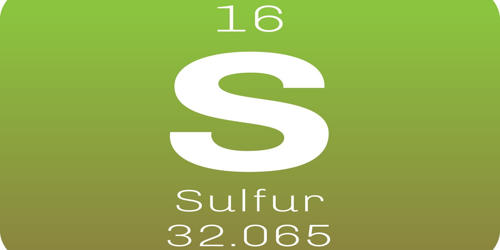Sulfur belongs to the chalcogen family. It is a chemical element with the symbol S and atomic number 16. It is a nonmetallic chemical element belonging to the oxygen group, one of the most reactive of the elements. It is abundant, multivalent, and nonmetallic. Under normal conditions, sulfur atoms form cyclic octatomic molecules with a chemical formula S8. Elemental sulfur is a bright yellow, crystalline solid at room temperature. It reacts with all metals except gold and platinum, forming sulfides; it also forms compounds with several nonmetallic elements.
Sulfur is the tenth most common element by mass in the universe and the fifth most common on Earth. Though sometimes found in pure, native form, sulfur on Earth usually occurs as sulfide and sulfate minerals. Pure sulfur is a tasteless, odorless, brittle solid that is pale yellow in color, a poor conductor of electricity, and insoluble in water. Being abundant in native form, sulfur was known in ancient times, being mentioned for its uses in ancient India, ancient Greece, China, and Egypt. Many important metal ores are compounds of sulfur, either sulfides or sulfates.
- atomic number: 16
- atomic weight: 32.064
- melting point: rhombic 112.8 °C (235 °F); monoclinic 119 °C (246 °F)
- boiling point: 444.6 °C (832 °F)
- density: (at 20 °C [68 °F])
- rhombic: 2.07 grams/cm3
- monoclinic: 1.96 grams/cm3
- oxidation states: −2, +4, +6
In nature, it occurs as the pure element or as sulfide and sulfate minerals. It is an essential element for all life, but almost always in the form of organosulfur compounds or metal sulfides. It is especially important for humans because it is part of the amino acid methionine, which is an absolute dietary requirement for us. Three amino acids (cysteine, cystine, and methionine) and two vitamins (biotin and thiamine) are organosulfur compounds. Many cofactors also contain sulfur, including glutathione, thioredoxin, and iron-sulfur proteins.
Elemental sulfur is not toxic, but many simple sulfur derivates are, such as sulfur dioxide (SO2) and hydrogen sulfide. It is one of the core chemical elements needed for biochemical functioning and is an elemental macronutrient for all living organisms. Seawater contains about 0.09 percent sulfur in the form of sulfate.
Uses
The greatest commercial use of the element is the production of sulfuric acid for sulfate and phosphate fertilizers and other chemical processes. It is used in the vulcanization of black rubber, as a fungicide and in black gunpowder. The element sulfur is used in matches, insecticides, and fungicides. The most important of sulfuric acid’s many uses is in the manufacture of phosphoric acid, to make phosphates for fertilizers.
It is also used in batteries, detergents, fungicides, manufacture of fertilizers, matches, and fireworks. Many sulfur compounds are odoriferous, and the smells of odorized natural gas, skunk scent, grapefruit, and garlic are due to organosulfur compounds. Hydrogen sulfide gives the characteristic odor to rotting eggs and other biological processes. Others are used in silver polish, and in the production of pesticides and herbicides.
















